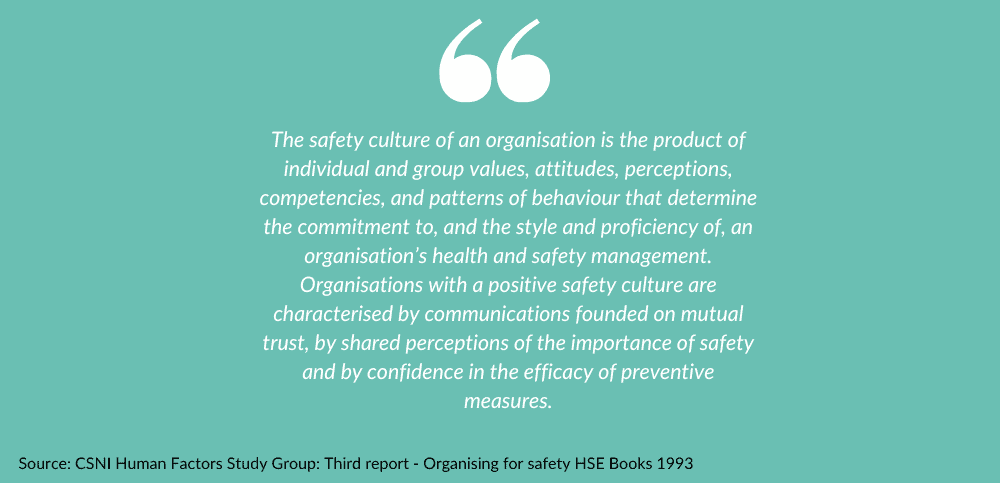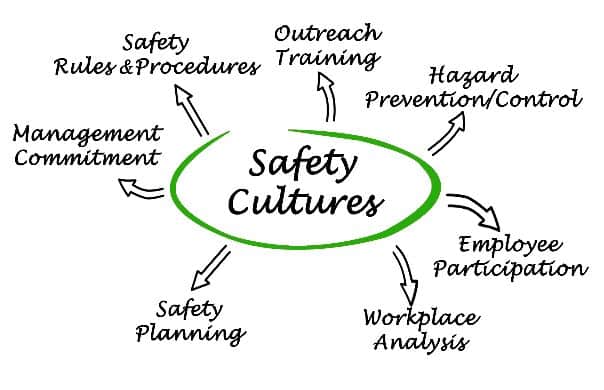17 Jan 2023

Building health & safety as part of your culture, is the most effective way of keeping your employees safe. That’s not all this achieves, a positive health and safety culture can also:
However, creating a positive health and safety culture is not just providing appropriate health and safety signage, PPE, a safety induction briefing or a box ticking exercise. It’s about how things are done, the behaviour and attitude of ALL employees, learning and adapting and preventing incidents in the first place. Developing a safety culture takes time and dedication and has to come directly from the top level, the senior management.
It is about an organisation and individuals taking ownership for their own health and safety and the health and safety of those around them, it is about being accountable.
Behavioural safety recognises workers as human beings with a genuine interest in their own wellbeing, who contribute best when they engage and take ownership. The human element means that desired results are rarely instantaneous and require different management arrangements to complement proven engineered and procedural systems.

Below are 8 tips to assist you in building health & safety as part of your culture within your organisation.
Build health and safety into your company values, ensure that clearly defined health and safety policies are in place and reviewed and updated and that everyone is aware of them. Include health and safety aspects within job descriptions. Make safety the first agenda point on every department meeting and document future strategies for improvement. Ensure you have consistent safe working practices that employees have been involved with developing.
All stakeholders of the organisation should be involved from contractors to suppliers, with a heavy investment from Management. Open conversations should be encouraged and the opportunity to report incidents and accidents should be provided and actively encouraged, without any backlash. Consider adding health and safety suggestion boxes. Employees need to feel empowered to make a difference and have a positive attitude to change the workplace for the better. Together Everyone Achieves More.
“Tell me and I forget, teach me and I remember, involve me and I learn.” – Benjamin Franklin
Keep employees up-to-date with regular changes in processes, legal requirements etc, include this on company intranet sites, noticeboards and team meetings. Ask for employees advice on how things can be improved. Ensure everyone is informed of your health and safety policies.
Everyone takes ownership for their own personal health and safety, but also that of the rest of their team and those around them that are affected by the business. Define individual roles where health & safety aspects are included. Consider adding health and safety objectives into annual appraisals so that these are measurable.
Introduce regular toolbox talks to discuss health and safety risk management issues. Invest in quality training for all, so they gain hands on experience and have regular quizzes to test knowledge, make it fun! Behavioural Safety Training focuses on identifying and providing interpersonal feedback for the critical behaviours that may lead to or prevent injury, analysing the factors that contribute to critical safety-related behaviours, and developing interventions to increase the frequency of safe and decrease the occurrence of at-risk behaviour.
Invest in a strong incident and accident reporting system, don’t rely on paper records that can be lost and don’t just record and action accidents, but also near misses and hazards to prevent future incidents. Ensure you have an incident portal that can provide clear and quick analysis, to save time and provide regular reporting to the Management team.
To ensure that the culture is valued, recognise individuals or departments for their additional investment, those that go the extra mile and drive initiatives forward. Celebrate your successes. Employee of the month or year awards, best health and safety initiatives.
Don’t become complacent, no organisation is perfect so always strive for improvement. Use internal and external auditing processes to measure improvements and set performance indicators.
In summary: The four ‘C’s of positive health and safety culture:
Competence: Recruitment, training and advisory support
Control: Allocating responsibilities, securing commitment, instruction, and supervision.
Co-operation: Between individuals and groups.
Communication: Spoken, written and visible.
Source: HSE.gov.uk
If you need advice with building health & safety as part of your culture, please contact us on 01527 833834.